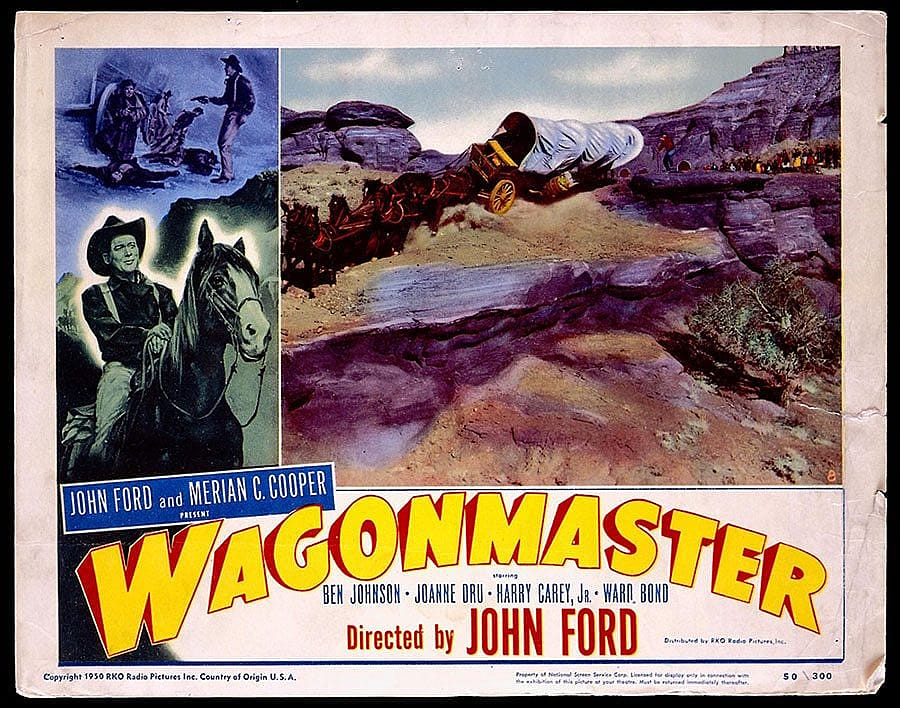Directed by John Ford – Points West Online
Originally published in Points West in Winter 1999
Directed by John Ford
By Lillian Turner
Former Director of Public Programs
Ed. note: This is the third of three posts tracing the evolution of the public’s perception of the cavalry in the West from novelist Charles King to short story and script writer James Warner Bellah whose stories were then translated to the screen by director John Ford. Read post 1. Read post 2.
Around her neck she wore a yellow ribbon
She wore it in December and the merry month of May.
And if you asked her why the yellow ribbon,
She’d say it’s for her lover in the U.S. Cavalry…
With guidons flying, the troopers of Company C rode out from Fort Starke into the awesome landscape of Monument Valley and onto the screen in one of the movies which comprise John Ford’s cavalry trilogy.
Few people today are familiar with the novels of Charles King; some may have read the short stories of James Warner Bellah; but many have formed their images of the post-Civil War military in the West from Fort Apache (Argosy Pictures, 1948), Rio Grande (Argosy Pictures, 1950), and She Wore a Yellow Ribbon (Argosy Pictures, 1949).
Director John Ford’s affectionate portrayal of the frontier cavalry is set in the time frame of Custer and the Indian wars of the northern plains, Fort Apache being a fictionalized telling of the Battle of the Little Big Horn. For these films, Ford also created a fictional setting, transferring his troops south to Monument Valley on the Arizona/Utah border.
For John Ford, the image of cavalry soldiers fighting and dying amid Monument Valley’s formations, with billowing clouds dwarfing the human drama, had an almost mystical appeal…. “I think you can say that the real star of my westerns has always been the land.”
The grandeur of Monument Valley, however, did not overshadow the importance of the cast Ford chose for these films. Many of them were the familiar faces of Ford’s stock company, the group of actors who appeared regularly in many of his films: John Wayne, Maureen O’Hara, Mildred Natwick, Ben Johnson, Ward Bond, Francis Ford, Victor McLaglen, Harry Carey, Jr., and others.
Harry Carey, Jr.
Ed. note: In February 2000, the Center, in conjunction with its exhibition Novel Adventures: The Life and Writings of General Charles King, hosted a seminar exploring the cavalry through the lens of King’s novels, to the scripts of James Warner Bellah, to the films of John Ford. Harry Carey Jr. was the featured presenter during the seminar.
Harry Carey Jr. was, at the time, the last surviving member of the John Ford stock company of actors. He appeared in more than one hundred feature films and scores of television shows.
Carey’s film credits include She Wore a Yellow Ribbon, Rio Grande, The Searchers, Wagonmaster, Three Godfathers, and four films directed by John Ford. Other Carey films include The Long Riders, The Whales of August, Crossroads, and Tombstone. Son of film stars Harry and Olive Carey, the actor grew up in the world of Hollywood’s westerns, never planning a film career for himself.
John Ford chose otherwise, selecting Carey for a role in the remake of Three Godfathers, a film dedicated to Harry Carey, Sr., Ford’s friend and first western film star. Carey’s recall of the making of this and other Ford films was richly filled with behind-the-scenes anecdotes. Harry Carey Jr. died in 2012.
Post 108
Written By
Nancy McClure
Nancy now does Grants & Foundations Relations for the Center of the West's Development Department, but was formerly the Content Producer for the Center's Public Relations Department, where her work included writing and updating website content, publicizing events, copy editing, working with images, and producing the e-newsletter Western Wire. Her current job is seeking and applying for funding from government grants and private foundations. In her spare time, Nancy enjoys photography, reading, flower gardening, and playing the flute.












